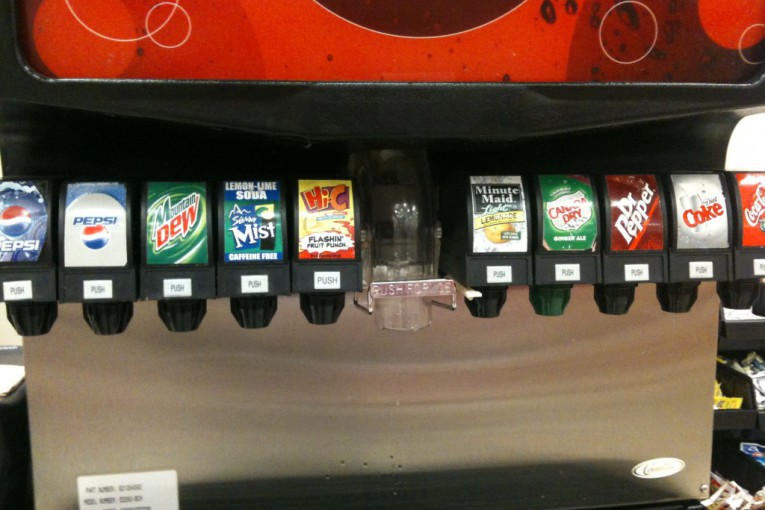
 by Leanna Sweha
by Leanna Sweha
Here we will look at what researchers at UC Davis are learning about the health effects of consuming sugar-sweetened beverages.
Dietary added sugars
The most common sugars added to foods and drinks are sucrose and high-fructose corn syrup (HFCS). Sucrose, or table sugar, contains equal amounts of fructose and glucose. It is derived from sugar cane and sugar beets. HFCS used in drinks contains 55% fructose and 45% glucose. HFCS is derived from corn starch through a chemical transformation from glucose to fructose.
The use of HFCS by the food and beverage industry increased significantly from 1970–2000, principally as a replacement for sucrose. However, sucrose is still the dominant sweetener – by a factor of nine over HFCS.
Evidence that added sugars increase cardiovascular disease risk
Kimber Stanhope, Ph.D., Associate Researcher in the UC Davis School of Veterinary Medicine, is a major investigator in a 5-year NIH-funded clinical study to assess the relative effects of sustained consumption of dietary added sugars in humans.
In 2009, she published a study showing that older, overweight men and women who consumed 25% of their energy as fructose in beverages for 10 weeks showed increased risk factors for cardiovascular disease compared to men and women who consumed 25% of their energy as glucose in beverages.
The fructose group showed elevated ldl-cholesterol, impaired insulin sensitivity, and increased intra-abdominal fat.
In 2011, she published a study showing that young adults who consumed 25% of their energy as HFCS in beverages for 2 weeks showed significantly increased risk factors for cardiovascular disease compared to young adults who consumed 25% of their energy as glucose in beverages.
Dr. Stanhope’s research was featured on CBS’ 60 Minutes in 2012.
Just last month, Dr. Stanhope’s group published another study showing that consumption of beverages providing 0, 10, 17.5 or 25% energy requirement from HFCS resulted in dose-dependent increases of risk factors for cardiovascular disease within 2 weeks in young adults.
Dr. Stanhope said that statistically, the relationship between the percentage HFCS consumed and the increase in risk factors observed in the study looks linear. That is, double your intake of HFCS and you double your risk of cardiovascular disease. This is consistent with a population study on adult consumption of total added sugars published last year. That study suggests that, over the long-term, high percentage intake of added sugar leads to at least a doubling of risk for cardiovascular disease.
Dr. Stanhope explained that, although the subjects in her studies were adults, it is reasonable to expect that children face similar risks from consuming sugary drinks.
17% of children in the US are overweight, and, as with adults, their excess body weight is associated with fatty-liver disorders, insulin resistance, and increases in risk factors for cardiovascular disease.
Consuming sugar as a comfort food may be self-reinforcing.
Dr. Stanhope collaborated in this study with Associate Professor of Nutrition Kevin Laugero, Ph.D., who directs the Stress Biology and Nutrition Research Lab at the USDA Western Human Nutrition Research Center.
This study showed that consumption of sugar while under stress reduces production of the stress hormone cortisol through what may be a negative feedback mechanism in the brain’s limbic system.
The study involved nineteen younger adult women ranging from healthy weight to obese who consumed either a sucrose- or aspartame-sweetened beverage three times per day for 2 weeks.
The women performed a timed mental arithmetic task known to induce stress. The researchers measured cortisol from saliva and brain activity using functional magnetic resonance imaging.
The group that consumed sucrose had lower stress-induced cortisol levels compared to the aspartame group. Further, the group that consumed sucrose showed significantly higher activity in the hippocampus, a part of the limbic system involved in memory and spatial relations. The hippocampus is typically inhibited during acute stress.
The researchers concluded that sugar consumption may inhibit the hypothalamus-pituitary-adrenal (HPA) axis – which controls cortisol production – via a metabolic signal to the hippocampus.
The authors state, “These experimental findings support a metabolic-brain-negative feedback pathway that is affected by sugar and may make some people under stress more hooked on sugar and possibly more vulnerable to obesity and its related conditions.”
Leanna M Sweha, JD, has been a resident of Davis for 20 years. As a young molecular biologist in a USDA lab working to engineer Roundup-resistant corn, she grew interested in sustainable agriculture. Fascinated with the legal and policy issues of agricultural genetics, she became an attorney specializing in agricultural and natural resources law. She has worked for the California Resources Agency and the UC Davis Office of Research.

So how much sugar is contained in low fat milk? How much more than in whole milk? That is an issue that “Dan in a Bubble” and his ilk fail to address.
why have you decided to personalize this to dan wolk?